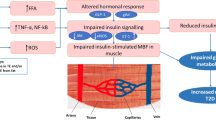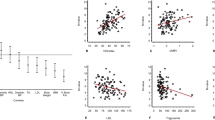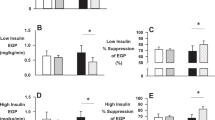Abstract
The inability to augment capillary blood volume (CBV) in response to insulin or glucose is thought to contribute to insulin resistance (IR) by limiting glucose uptake in key storage sites. Understanding the mechanisms that contribute to impaired CBV augmentation early in the onset of IR may lead to new future therapies. We hypothesized that inactivity alters the balance of vasoactive eicosanoids and contributes to microvascular IR. In ten activity-restricted (AR) and six normal activity adult male rhesus macaques, contrast-enhanced ultrasound of skeletal muscle blood flow and CBV was performed at baseline and during intravenous glucose tolerance test (IVGTT). Plasma was analyzed for vasoconstrictor hydroxyeicosatetraenoic acids (HETEs) and the ratio of vasodilatory epoxyeicosatrienoic acids (EETs) to their less biologically active dihydroxyeicosatrienoic acids (DHETs) as an indirect measure of soluble epoxide hydrolase activity. AR primates were IR during IVGTT and had a 45% lower glucose-stimulated CBV response. Vasoconstrictor 18-HETE and 19-HETE and the DHET/EET ratio were markedly elevated in the AR group and correlated inversely with the CBV response. In addition, levels of 18-HETE and 19-HETE correlated directly with microvascular IR. We conclude that a shift toward increased eicosanoid vasoconstrictor tone correlates with abnormal skeletal muscle vascular recruitment and may contribute to IR.
This is a preview of subscription content, access via your institution
Access options
Subscribe to this journal
Receive 12 print issues and online access
$259.00 per year
only $21.58 per issue
Buy this article
- Purchase on Springer Link
- Instant access to full article PDF
Prices may be subject to local taxes which are calculated during checkout

Similar content being viewed by others
References
Coggins M, Lindner J, Rattigan S, Jahn L, Fasy E, Kaul S et al. Physiologic hyperinsulinemia enhances human skeletal muscle perfusion by capillary recruitment. Diabetes 2001; 50: 2682–2690.
Vincent MA, Clerk LH, Lindner JR, Price WJ, Jahn LA, Leong-Poi H et al. Mixed meal and light exercise each recruit muscle capillaries in healthy humans. Am J Physiol Endocrinol Metab 2006; 290: E1191–E1197.
Scherrer U, Randin D, Vollenweider P, Vollenweider L, Nicod P . Nitric oxide release accounts for insulin's vascular effects in humans. J Clin Invest 1994; 94: 2511–2515.
Solomon TP, Haus JM, Li Y, Kirwan JP . Progressive hyperglycemia across the glucose tolerance continuum in older obese adults is related to skeletal muscle capillarization and nitric oxide bioavailability. J Clin Endocrinol Metab 2011; 96: 1377–1384.
Steinberg HO, Brechtel G, Johnson A, Fineberg N, Baron AD . Insulin-mediated skeletal muscle vasodilation is nitric oxide dependent. A novel action of insulin to increase nitric oxide release. J Clin Invest 1994; 94: 1172–1179.
Vincent MA, Barrett EJ, Lindner JR, Clark MG, Rattigan S . Inhibiting NOS blocks microvascular recruitment and blunts muscle glucose uptake in response to insulin. Am J Physiol Endocrinol Metab 2003; 285: E123–E129.
Vincent MA, Clerk LH, Lindner JR, Klibanov AL, Clark MG, Rattigan S et al. Microvascular recruitment is an early insulin effect that regulates skeletal muscle glucose uptake in vivo. Diabetes 2004; 53: 1418–1423.
Laakso M, Edelman SV, Brechtel G, Baron AD . Decreased effect of insulin to stimulate skeletal muscle blood flow in obese man. A novel mechanism for insulin resistance. J Clin Invest 1990; 85: 1844–1852.
Clerk LH, Vincent MA, Barrett EJ, Lankford MF, Lindner JR . Skeletal muscle capillary responses to insulin are abnormal in late-stage diabetes and are restored by angiotensin-converting enzyme inhibition. Am J Physiol Endocrinol Metab 2007; 293: E1804–E1809.
Clerk LH, Vincent MA, Jahn LA, Liu Z, Lindner JR, Barrett EJ . Obesity blunts insulin-mediated microvascular recruitment in human forearm muscle. Diabetes 2006; 55: 1436–1442.
Chadderdon SM, Belcik JT, Smith E, Pranger L, Kievit P, Grove KL et al. Activity restriction, impaired capillary function, and the development of insulin resistance in lean primates. Am J Physiol Endocrinol Metab 2012; 303: E607–E613.
Iyer A, Kauter K, Alam MA, Hwang SH, Morisseau C, Hammock BD et al. Pharmacological inhibition of soluble epoxide hydrolase ameliorates diet-induced metabolic syndrome in rats. Exp Diabetes Res 2012; 2012: 1–11.
Luria A, Bettaieb A, Xi Y, Shieh GJ, Liu HC, Inoue H et al. Soluble epoxide hydrolase deficiency alters pancreatic islet size and improves glucose homeostasis in a model of insulin resistance. Proc Natl Acad Sci USA 2011; 108: 9038–9043.
Mustafa S, Sharma V, McNeill JH . Insulin resistance and endothelial dysfunction: are epoxyeicosatrienoic acids the link? Exp Clin Cardiol 2009; 14: e41–e50.
Shim CY, Kim S, Chadderdon S, Wu M, Qi Y, Xie A et al. Epoxyeicosatrienoic acids mediate insulin-mediated augmentation in skeletal muscle perfusion and blood volume. Am J Physiol Endocrinol Metab 2014; 307: E1097–E1104.
Roche C, Besnier M, Cassel R, Harouki N, Coquerel D, Guerrot D et al. Soluble epoxide hydrolase inhibition improves coronary endothelial function and prevents the development of cardiac alterations in obese insulin-resistant mice. Am J Physiol Heart Circ Physiol 2015; 308: H1020–H1029.
Fleming I . Cytochrome p450 and vascular homeostasis. Circ Res 2001; 89: 753–762.
Roman RJ . P-450 metabolites of arachidonic acid in the control of cardiovascular function. Physiol Rev 2002; 82: 131–185.
Hamburg NM, McMackin CJ, Huang AL, Shenouda SM, Widlansky ME, Schulz E et al. Physical inactivity rapidly induces insulin resistance and microvascular dysfunction in healthy volunteers. Arterioscler Thromb Vasc Biol 2007; 27: 2650–2656.
Nosova EV, Yen P, Chong KC, Alley HF, Stock EO, Quinn A et al. Short-term physical inactivity impairs vascular function. J Surg Res 2014; 190: 672–682.
Acknowledgements
Dr Chadderdon was funded by a Fellow-to-Faculty Award (0875005N) from the American Heart Association and grant 5KL2TR000152 from the National Institutes of Health (NIH). Dr Lindner is supported by grants, R01-HL-078610 and R01-HL-111969 from the NIH. Dr Grove is supported by grant R01-DK-79194 from the NIH. The Oregon National Primate Research Center is supported by a National Center for Research Resources grant (S10-RR-024585) and a Research Program Projects and Centers grant (P51 DK011092) from the NIH. This publication was made possible with support from the Oregon Clinical and Translational Research Institute (OCTRI), grant number UL1 RR024140 from the National Center for Advancing Translational Sciences, a component of the NIH and NIH Roadmap for Medical Research.
Author information
Authors and Affiliations
Corresponding author
Ethics declarations
Competing interests
The authors declare no conflict of interest.
Additional information
Supplementary Information accompanies this paper on International Journal of Obesity website
Supplementary information
Rights and permissions
About this article
Cite this article
Chadderdon, S., Belcik, J., Bader, L. et al. Vasoconstrictor eicosanoids and impaired microvascular function in inactive and insulin-resistant primates. Int J Obes 40, 1600–1603 (2016). https://doi.org/10.1038/ijo.2016.117
Received:
Revised:
Accepted:
Published:
Issue Date:
DOI: https://doi.org/10.1038/ijo.2016.117
This article is cited by
-
A Targeted Lipidomic Reveals CYP450-Derived Oxylipin Linked to the Inflammatory Response by Polycyclic Aromatic Hydrocarbon Exposure in Children
Exposure and Health (2023)
-
Cyp2c44 epoxygenase-derived epoxyeicosatrienoic acids in vascular smooth muscle cells elicit vasoconstriction of the murine ophthalmic artery
Scientific Reports (2021)



